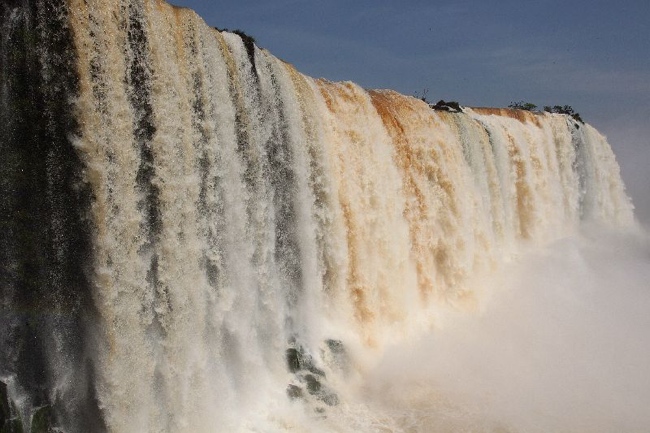
Stephen King’s market place in Santelmo
Alice is recovering from a mild to moderate cold (that she caught from me) and so passed on a few of yesterday’s goings-on, starting with an indoor marketplace. A somewhat grungier version of Baltimore’s Lexington Market or Philadelphia’s Reading Terminal Market, Buenos Aires’ Santelmo market is housed in a cavernous warehouse space that, but for being too small, might in some other life have been an abandoned railway station. As it is, most of the stalls were closed since we we there on a weekday — weekends are the big market time — which gave the place a somewhat forlorn and slightly spooky aura; you get the idea from the photo at left.
But there were nonetheless a fair number of places open, mostly butchers and produce stalls (with very nice looking produce, I should add), as well as a certain number of hard-to-describe places selling extremely random odds and ends: antique dolls, mismatched china sets, pots and pans, household utensils and tools of uncertain purpose, long-obscure toys (anybody remember Topo Gigio, the Italian mouse puppet from the Ed Sullivan Show? He’s here.), etc., etc.
 |
 |
It was an unusual but strangely interesting way to spend an hour or so. So to continue…
Buenos Aires sits on the Rio La Plata, or “silver river”. Why that name? Is it silver-colored? No. In fact, because of an enormous amount of suspended sediment, the whole river and the delta at its mouth are the color of chocolate milk. It is a very odd sight, the broad and tranquil river flowing into a wide delta stretching to the horizon, all the water a pleasant but surreal café au lait brown that makes it feel like someone has Photoshopped your retina by somehow shifting the color scale. In any case it is definitely not silver.
Ah then, perhaps there are some big silver mines along it. Nope, not that either. Turns out that the Argentines are prone to hyperbole and the original settlers were misled by the natives into thinking that somewhere at the headwaters of the river there were major silver deposits. So they optimistically named the river after them and basically got stuck with the name even after the eponymous silver turned out to be mostly nonexistent.
We spent a pleasant sunny morning on a boat out on that earthy-looking water, or rather I did; Alice had that cold and decided to sleep in that day. But the rest of us boarded our van and drove for an hour to the town of Tigre, first passing some of Buenos Aires’ extensive and remarkably constructed shantytowns, as you see here.

No plumbing, no problem — we got cable!
The slum is vast, dense and essentially improvised, with surprisingly sophisticated structures constructed mostly out of scrounged materials, and sustained by bootleg connections to city utilities. They may not all have water, but you better believe they all have TV.

Liquid bus stop
We continued pass the tenements for another half hour or so to the town of Tigre, whose mascot and town logo is exactly what you think it would be. Tigre is a pleasant resort town near the delta of the river whose claim to fame is an entire community that lives on the water. The delta is crisscrossed by river channels — again that chocolate brown water — that are perhaps 50 or 75 yards wide and lined by a mix of residences and vacation houses whose condition ranges from luxurious to caved-in. There is a local “bus” service rather like a water taxi with fixed stops; you can see one at right. Note the color of the water and the elegant wooden structure of the boat itself; a large fraction of boats plying these waters are genteel-looking low-slung dark wooden hulls, most of them dating back 50 or 60 years.

Groceries on the river
Some are are aquatic school buses, ferrying children to a school on the river bank; others, floating hardware and landscape stores selling tools and plants; and still others, floating grocery stores. (We pulled up to one of the latter and bought some crackers and fruit through a port hole…kinda cool to do.) You can see one of the grocery boats at left; the one we stopped at resembled the dark, low-riding ones. The proprietors were greatly amused at the dozen or so childlike tourists sticking their arms through the window and trying to call out orders in execrable Spanish. But we did get our crackers and fruit.
It was a mostly sunny day with temperatures in the low 70’s, a welcome respite from the literal glacial conditions that we had been trekking around in for the past several days. Indeed, when we pulled back into port we stopped for ice cream — Chileans and Argentines love their ice cream — which made the whole outing feel like some kind of cross between summer vacation and a school class trip.
When I returned to the hotel Alice was up and about and ready to explore the city a bit more, which is to say go shopping. She had her eye on a purse that she had seen briefly in a store window that we had driven past, quite close to our hotel, and when we walked there we were delighted to learn that the store was called “Carpincho”, which is the Spanish word for capybara (the world’s largest rodent…look it up!) and specialized in leather from the that particular beast. This was a wonderful thing because I myself am the longtime proud owner of a capybara leather jacket that I bought here in Buenos Aires about a dozen years ago whilst attending a conference. We have long called it my “rat coat”, and Alice now has a “rat purse” that complements it perfectly. It is a speckled suede-like leather, very beautiful and soft to the touch. We are now fully rodent-accessorized.
Our next goal was a well-known synagogue, Buenos Aires having a large Jewish population and this particular temple supposedly very elaborate and offering guided tours. But not, as it turned out, on Wednesdays. So we pounded on the door and when an Orthodox-looking gentleman answered I tried to talk our way in by playing the “I’m a Jewish tourist” card. He trumped it by playing the “Today is a Jewish holiday” card and said I could come to Sukkot services that evening if I wanted to see the place. Since I am extremely committed to avoiding religious services of any kind, we didn’t get to see the synagogue. So we visited the Teatro de Colón instead, Buenos Aires’ famous opera house and performing venue, hooking up with an English language tour of the building. It is beautiful and elaborate, built about 60 years ago in the style of the palace of Versailles.
This morning we continued our northward march towards the tropics, leaving Buenos Aires for Iguazú Falls (also spelled Iguassu and Iguaçu, in all cases with the accent on the last syllable). We’re now up at 26° latitude, just a few degrees south of the Tropic of Capricorn, which is a fancy way of saying that in stark contrast to our glacier visits of just a few days ago it is now 102° F and greater than 70% humidity. Or to put it even more simply, we are in Major Schvitzing Territory now.
I have been hyping the falls to Alice since I visited them on my previous trip here, and they did not disappoint. They are both higher than Niagara Falls (with cataracts ranging up to 280′ high), and with a higher water volume. As it happens, due to recent rainfalls the current volume is far higher than usual, with several million gallons per second thundering over the sides among all 270 cataracts. It is simply stunning, and you get up close and personal on a walkway that takes you right up into the spray of one of the larger cataracts. I will let a few photos do the talking:
See the boats? We will be on one tomorrow, getting very, very wet. But to continue…
…and to get a little more up close…

After completing the walkway up to the falls, we were not sated and so took a helicopter ride, from which vantage point they look like this:

I should mention that the falls are located at the “corner” where Argentina, Brazil, and Paraguay meet, and that this all took place on the Brazil side of the border. (We had to change to a Brazilian bus and go through passport control to cross the border; we applied for and received Brazilian visas for this purpose a few months ago.) Tomorrow we will explore the Argentine side, which is to say we will ride on one of those boats right up to the fall, which as I recall from my experience 12 years ago is like having a swimming pool dropped from 200 feet onto your head. Wet fun!
Tomorrow will also be our last night here. On Saturday the journey home begins, with a flight to Buenos Aires in the morning, and an evening red eye home.


Iguazu Falls is the only part of your journey th
I don’t know if Customs allows, but see if you can bring back a variety of breads to savor in the days immediately after your trip, before they start to show of their lack of preservatives. I recall that several countries down that way are rather proud of their breads, and that they’re pretty good and distinct enough to make it interesting. It’s not as if you need advice on souvenirs (though of course that won’t stop me 😉 having already obtained matching rodent accessories, but you know even if you don’t like drinking steeped pencil shavings, a mate gourd with a silver bombilla will help you to reminisce, and one can even trick friends who have not read your blog to try some! If you can get alcohol into the US, I’d see if the nearest store has some of those artisinal wines, though Quilmes lager would also be a nice shelf decoration if they don’t explode in your baggage. I volunteer to help you enjoy the wine =)
Had I been exposed to travelogues so wildly interesting, joyously written, and gorgeously illustrated as yours in my youth, I would not have resorted to reading literary fiction on the sly under my desk in Social Studies, Geography, and World History.